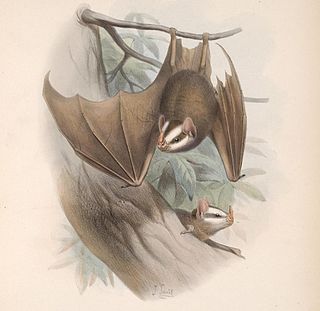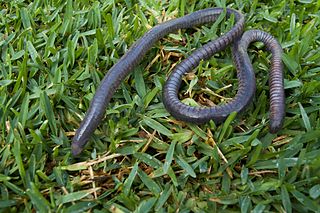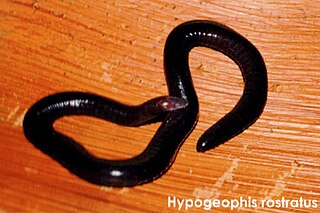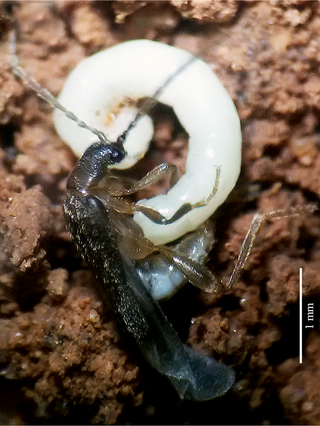
Leporinus is a genus of fish in the family Anostomidae native to South America. The fossil species Leporinus scalabrinii, known from the late Miocene of Entre Ríos in Argentina, has only recently been added to this genus after being misidentified as a species of primate under the name Arrhinolemur scalabrinii for over 100 years.

Chiroderma – big-eyed bats or white-lined bats – is a genus of leaf-nosed bat found in North America, Central America, and South America and the Lesser Antilles.
Gegeneophis danieli, the Amboli caecilian or Daniel's caecilian, is a species of caecilians in the family Indotyphlidae. It was discovered from near Amboli in Western Ghats of Maharashtra.
Indotyphlus maharashtraensis is a species of caecilians described in 2004 by scientists of Bombay Natural History Society and the Natural History Museum, London. It is only the second species of Indotyphlus known to science, and only known from its type locality near Humbarli village, Satara District, in the Western Ghats of Maharashtra, India. Common names Humbarli caecilian, Maharashtra caecilian, and Konkan tail-less caecilian have been coined for it.
Brasilotyphlus is a genus of caecilians in the family Siphonopidae. It was considered monotypic, containing only the species Brasilotyphlus braziliensis. However, two recently described species, Brasilotyphlus guarantanus and Brasilotyphlus dubium, have been placed in this same genus. All three species are endemic to Brazil. This genus has also been suggested as paraphyletic to Microcaecilia.

Caecilia gracilis is a species of caecilian in the family Caeciliidae. It is found in Brazil, French Guiana, Peru, Suriname, possibly Colombia, and possibly Guyana. Its natural habitats are subtropical or tropical moist lowland forests, moist savanna, plantations, rural gardens, and heavily degraded former forest.

Microcaecilia is a genus of caecilians in the family Siphonopidae.

Oscaecilia is a genus of caecilians in the family Caeciliidae. The genus is distributed in southeastern Central America and northern South America, possibly extending into southern Brazil. They are sometimes known as the South American caecilians.
Pithecopus ayeaye, also known as the reticulated leaf frog and reticulate leaf frog, is a species of frog in the subfamily Phyllomedusinae. It is endemic to Brazil. P. ayeaye is found in the transition zone between cerrado and Atlantic semi-deciduous forest, laying its eggs on leaves above streams or pools so the tadpoles, when hatched, fall into the water below. This species is under threat from habitat loss resulting from mining activity and fires, and is also affected by pollution from mining and pesticides. Its restricted range is likely to make it particularly vulnerable to these threats.

Taddei's serotine is a species of medium-sized bat belonging to the family Vespertilionidae. It is restricted to the Atlantic Forest of southern Brazil.
Coringasuchus is a genus of mesoeucrocodylian crocodyliform, perhaps a notosuchian. It is known from fossils including cranial material discovered in rocks of the early Cenomanian-age Upper Cretaceous Alcântara Formation, Cajual Island, northeastern Brazil. Coringasuchus was described by Alexander Kellner and colleagues in 2009. The type species is C. anisodontis.
Gegeneophis is a genus of amphibians in the family Grandisoniidae. They are found in southern and northeastern India.
Indotyphlus is a small genus of caecilians in the family Grandisoniidae. As caecilians in general, they superficially resemble earthworms. The genus is endemic to the Western Ghats, India. They are sometimes known as Battersby's caecilians.
Brasilotyphlus braziliensis is a species of caecilian in the family Siphonopidae. It was considered monotypic within Brasilotyphlus but a recently described species has been placed in this same genus. It is endemic to Brazil. Its habitat includes natural forests, dry tropical or subtropical. It is in danger of extinction because of the loss of its natural habitat.

The Grandisoniidae are a family of common caecilians found in Africa, Seychelles and India. Like other caecilians, they superficially resemble worms or snakes. The family was formerly known as Indotyphlidae.
Brasilotyphlus dubium is a species of caecilian in the family Caeciliidae. It is endemic to the state of Roraima in northern Brazil. It was described in 2018.

Jurasaidae is a family of elateroid beetles known from around a half-dozen species in two genera found the Brazilian Atlantic rainforest including drier transitional areas bordering the Caatinga. All known species have neotenic larva-like females and normal males, similar to some other elateroids. They occur in the soil horizon immediately under leaf litter, with the larvae likely being fungivorous, consuming the fluids of fungal hyphae.
Inaechelys is a potentially dubious genus of bothremydid pleurodiran turtle that was discovered in the Maria Farinha Formation of Brazil. The genus consists solely of type species I. pernambucensis.

Arrudatitan is an extinct genus of titanosaur sauropod dinosaur known from the Late Cretaceous (Campanian-Maastrichtian)-aged Adamantina Formation of Brazil. The type species, A. maximus, was named and described in 2011 as a species of Aeolosaurus, but was separated into its own genus in 2021. It was relatively gracile for a titanosaur.








